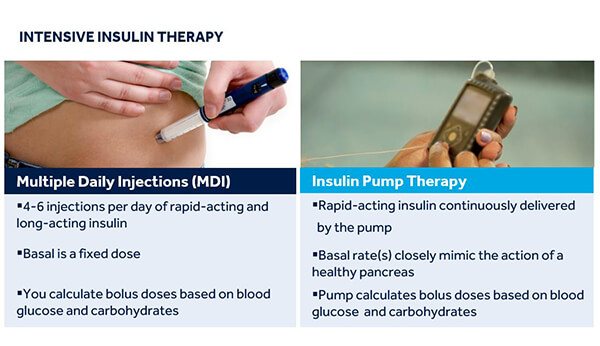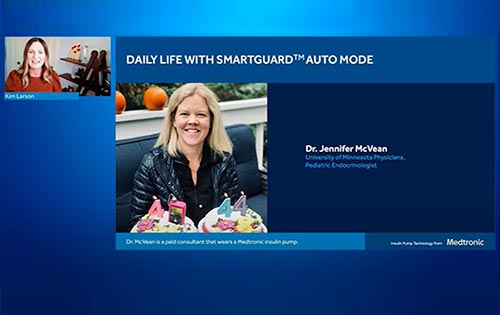On-demand webinar
Basics of insulin pump therapy

Watch a 20-minute video to learn more about:
- The basics of diabetes
- How to balance glucose and insulin
- How to balance carbohydrates and insulin
- The basics of insulin pump therapy, including how it works, how insulin pump therapy compares to multiple daily injections and how to wear it
- Latest ADA standard of glucose assessment: Time in Range
For live Q&A with a certified product trainer, sign up for an upcoming interactive webinar

Below is a transcript from a live webinar. Remember to consult with your health care professional before making any changes to your therapy.
Hello and welcome to your Pre-Pump Education class!
When you have diabetes and need to take insulin every day, an insulin pump is a great tool to help manage your insulin and blood sugar (glucose) levels. Today, we’ll discuss topics to help you prepare for starting on insulin pump therapy, including: basics of diabetes, balancing glucose and insulin, balancing carbohydrates and insulin, intensive insulin therapy and the basics of insulin pump therapy. Learning these concepts can help you better manage your glucose levels and be successful with starting on insulin pump therapy.
Let’s start by covering the basics of diabetes.
For better options to treat diabetes, it helps to learn what it is and how the body works.
Diabetes is a condition in the body where blood sugar levels are higher than normal.
This can happen when the body doesn’t make any insulin (type 1 diabetes), or the insulin that the body makes doesn’t work well (type 2 diabetes).
Glucose is the body’s fuel. Just like cars need fuel to run, the body needs glucose to work.
The body is made of cells and every cell needs energy. Your body uses glucose, or sugar, for energy.
You need some glucose in your body at all times.
So how does the body get glucose for energy?
When you eat, food travels into the stomach and digestive system. Food is broken down into nutrients, one of which is glucose.
Glucose gets absorbed into the bloodstream, then moves into the fluid that surrounds your tissues and cells.
Next, glucose moves into your cells with the help of a hormone called insulin. Insulin is the ‘key’ that moves glucose inside your cells, so your body has energy to live.
Insulin, a hormone made by the pancreas, helps to lower blood glucose levels by allowing glucose to move out of the blood and into your body’s cells. The pancreas releases insulin 24 hours a day, and insulin is released in two ways:
- A small amount (basal level) of insulin is released in between meals and while you sleep
- A larger amount (a bolus) of insulin is released after eating.
When you have diabetes, you may not make any insulin or not make enough insulin. So, you rely on taking insulin to lower your glucose levels.
Extra glucose that is not needed for energy right away is stored in the liver. Just like a car stores extra gas in its tank, the body stores extra fuel in the liver.
The liver releases glucose back into the blood stream for energy. This happens during sleep and exercise.
The pancreas makes another hormone called glucagon. You can think of glucagon as the opposite of insulin because it raises glucose levels.
Glucagon signals to the liver to release stored glucose back into the blood stream to help blood glucose levels rise.
The pancreas makes insulin and glucagon to help balance blood glucose.
Next, we’ll discuss balancing glucose and insulin.
A goal in managing diabetes is to take the right amount of insulin to balance the amount of glucose in your body and try to avoid high and low glucose levels. This can be difficult to do sometimes, but keeping your blood glucose in target range will help you feel your best. Your healthcare professional will help you figure out your ideal glucose target range, and the American Diabetes Association recommends a range for people with diabetes from 70 mg/dL to 180 mg/dL.
Is anyone familiar with time in range?
Time in range is defined as the percentage of time, or amount of time, spent “in range” defined as 70-180 gm/dL. The American Diabetes Association (ADA) and American Association of Clinical Endocrinologists (AACE) also have before meal and after meal glucose guidelines, and your healthcare professional will help you decide the best glucose range for you.
When you have diabetes, it’s important to try to avoid high and low glucose levels. Highs and lows don’t feel very good in the moment, and they can lead to complications in the long run. They can damage the small and large blood vessels in your body – the eyes, kidneys, nerves in your feet, heart, and brain.
Let’s talk about high glucose levels first.
For example, when you eat a meal glucose levels start to rise. If there is not enough insulin in the body, glucose can’t move into the cells. In this case, glucose will stay in the blood and fluid surrounding your cells. More insulin is needed to lower blood glucose levels.
Let’s talk about managing high glucose levels with diabetes.
Symptoms of high glucose levels include frequent urination, increased thirst, blurred vision, fatigue, and headache. Causes include too little insulin, illness, or infection.
It’s important to have a treatment plan for high glucose levels.
Low glucose levels are the opposite of high glucose levels.
When there is more insulin in the body than is needed and there is not enough sugar available, glucose levels will drop. It’s important to drink or eat sugar to make blood glucose levels go back up to a safe range.
If your glucose is so low that you cannot eat or drink sugar, someone can give you glucagon. Remember glucagon makes the liver release glucose into the blood, and glucose levels will rise as a result.
We’ll also discuss managing low glucose levels with diabetes.
Symptoms of glucose <70 mg/dL (mild hypoglycemia) may include:
- Sweating, shakiness or dizziness, nausea, hunger, and headache
Symptoms of glucose 54mg/dL to 69 mg/dL (moderate hypoglycemia) may include:
- Difficulty concentrating, blurry vision, weakness, confusion, and changes in mood
Causes may include too much insulin, stacking insulin, a decrease or delay in food intake, or an increase in exercise Just like high glucose levels, it’s important to have a treatment plan for low glucose levels.
Next, we’ll cover treating low glucose levels.
The Rule of 15 is commonly used as a guideline for treatment and includes the following steps:
- Check BG. If BG <70 mg/dL, consume 15 grams of a fast-acting carbohydrate.
- Wait 15 minutes and test blood glucose again.
- If blood glucose remains <70 mg/dL, repeat steps 1 and 2 until glucose is within range.
Items that contain 15 grams include:
- 3 to 4 glucose tablets
- 5 jelly beans
- 4 oz juice or soda (not diet)
- 8 oz milk (low or non-fat)
- 1 Tbsp sugar or honey
If BG is less than 50 mg/dL, consider treating with 20-30 grams of fast-acting carbohydrate.
Severe hypoglycemia is a low blood glucose level that requires assistance from another person to treat. If glucose is so low you cannot eat or drink fast acting carbohydrates, someone can give you glucagon to make BG levels rise.
Another important part of managing diabetes is balancing carbohydrates and insulin.
But what are carbohydrates? Food contains 3 main nutrients: protein, fat, and carbohydrate (carbs).
When carbs are digested, they get broken down into glucose (or sugar), which enters the blood stream and makes blood glucose (or blood sugar) levels go up.
Insulin helps glucose move from the bloodstream into the cells where it can be used for energy.
Now, does this mean that because carbohydrates make your sugars rise that they are bad for you? No. Carbohydrates should be a part of your daily intake. Choose healthy sources of carbohydrates like vegetables, whole grains, beans, and fruits.
To count carbohydrates, you must first know which foods contain carbohydrates.
Starches such as breads, cereals, crackers, rice, beans (legumes), grains and pasta; and starchy vegetables like potatoes, peas, and corn are mostly carbohydrates.
Fruits and fruit juices as well as milk and yogurt also contain carbs.
Of course, sweets and desserts have carbs and include things like candy, cookies, cake and pastries, ice cream, pudding, honey, table sugar, syrup, jelly, regular soda, and sports drinks.
Carbohydrate counting, or carb counting for short, is one approach to meal planning. If you have diabetes, you may have been asked to count your carbs to help manage your glucose levels after meals. If you take insulin, carb counting can be a great way to help you figure out how much insulin to give for the food you’re eating.
What is carb counting? Carb counting is adding up the grams of carbs you want to eat, so that you can give the right amount of insulin for the food you eat.
Why count carbs? To match your insulin to the food you want to eat and better manage glucose levels to avoid highs and lows.
Carbohydrate counting gives you more flexibility and helps your glucose levels stay in balance.
The amount of insulin needed by the body will vary depending on the amount of carbohydrate you eat. If you eat more carbs they make more glucose which means you will need more insulin. If you eat less carbs they make less glucose so you need less insulin.
Your healthcare professional will help you figure out your insulin dose relative to how many carbs you eat. This is called your carb ratio.
You can also learn more by attending a Medtronic Carb Counting webinar. If you’re interested, I can provide you with more information.
Now let’s talk about some of the basics of insulin pump therapy.
Remember, basal insulin is released by the pancreas in small amounts in between meals and during sleep.
The pump automatically releases rapid-acting insulin every few minutes, 24 hours a day. This is the basal rate, which you can think of as ‘background’ insulin delivery. The pump’s basal insulin delivery is meant to match the liver’s steady release of glucose between meals and while you sleep.
The pump can be customized with a single basal rate, or it can be set with different basal rates during the day and night to better match your body’s needs. Basal rates can be adjusted as needed for things such as exercise and activity.
Earlier, we also covered that the pancreas releases larger amounts of insulin, called bolus insulin. With diabetes, bolus insulin is a larger dose of insulin you give when eating food, or any time you have a high blood glucose (BG) value. Bolus insulin is meant to match the rise in blood glucose levels from eating food.
Being able to deliver a bolus through an insulin pump when eating or for high glucose levels offer flexibility.
There are different types of insulins available, each type working a little differently. The ways these insulins are used together and delivered are calling insulin regimens. One main insulin regimen is intensive insulin therapy, which includes multiple daily injections and insulin pump therapy. Let’s take a closer look at both of these therapy options.
Multiple Daily Injections, also referred to as MDI, includes:
- Long-acting basal insulin in combination with a rapid-acting bolus insulin. MDI often includes 4-6 injections per day of long-acting and rapid-acting insulin.
- With MDI, long-acting basal insulin is a fixed dose, and it cannot be quickly adjusted for exercise or activities that require more or less basal insulin. This may make avoiding highs or lows difficult at times.
- With MDI, you are responsible for calculating food boluses based on the amount of food (carbohydrates) eaten and a current blood glucose value.
Insulin can be continuously administered through Insulin Pump Therapy, which uses only rapid-acting insulin. No long-acting insulin is needed when using an insulin pump.
- The pump is programmed to give a small amount of basal insulin continuously throughout the day and night, which closely mimics the action of a healthy pancreas.
- The pump calculates bolus doses based on blood glucose and carbohydrates entered. IPT allows for flexibility in the timing and frequency of meals and snacks. This is similar to MDI; however, can be done without frequent injections. Insulin can be easily adjusted for change in insulin needs, such as exercise, schedule changes, and illness.
- When taking multiple daily injections, a person needs both long-acting insulin and rapid-acting insulin. As we discussed in the previous slide, when using a pump only rapid-acting insulin is needed.
- A disadvantage of using long-acting insulin is that a large volume of insulin is often injected at one time. This can lead to insulin “pooling” under the skin and less consistent absorption day-to-day.
- The advantage of using rapid-acting insulin is that smaller amounts of insulin are delivered, so the body has more consistent absorption day-to-day. This helps reduce day-to-day variations in insulin absorption that are often seen with injections of long-acting insulins to help better manage glucose levels.
- With long-acting insulin, you cannot take back the insulin once you have injected it. It’s there, working in your body, whether you want it to or not. This may sometimes contribute to low glucose levels, like during and after exercise.
- Suspending the pump stops basal insulin delivery. Stopping a bolus delivery allows you to stop the (remaining) delivery of a bolus.
- With multiple daily injections, you may forget your insulin at home, and unfortunately if you do, you must skip a dose of insulin. This almost certainly leads to high glucose levels.
- With an insulin pump, you always have your insulin with you to bolus for food or to correct a high BG. Always having your insulin there when you need it may help you avoid highs and better manage your glucose levels.
Where and how to wear the pump are commonly asked questions among new insulin pump users. Most individuals find that wearing an insulin pump presents no problem and that it can be worn in a variety of ways. It typically only takes a short amount of time to find the ways that work best for you. Remember, it takes time to adjust to something new! Accessories are available that can add to the convenience of wearing, protecting, and concealing your pump.
Consider the following ways to wear an insulin pump:
- Use the clip that comes with your pump and clip it to a waist band or belt
- Put the pump into the pocket of your pants, shorts or shirt
- Slip the pump into your bra with the screen facing away from your skin
When people first start wearing an insulin pump, they wonder where to put it when they sleep. Try the following:
- Clip it to the waist of your pajama bottoms or on your pajama top
- Place it next to you in the bed, under your pillow or on a bedside table
When you use an insulin pump, it is important to check your blood sugar periodically. You’ll learn more about a blood glucose monitoring schedule during device training for your insulin pump.
In addition, some people on a pump also use a continuous glucose monitor (CGM). This is a sensor that lets a person continuously know their interstitial glucose levels with a new value every 5 minutes. This is called the sensor glucose (SG) value.
The following resources are helpful if you’re looking for more information.
The American Diabetes Association has information on diabetes management and care.
CalorieKing is an app and online website to help with counting carbohydrates.
Learn more about Medtronic support and check out the live and pre-recorded webinars to help support you in your journey with insulin pump therapy.
Whether you choose pump therapy because of its flexibility, convenience or to help improve your glucose control, it will be a valuable tool in helping to manage your diabetes.
Thanks for joining class!


